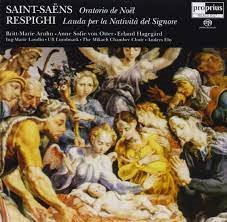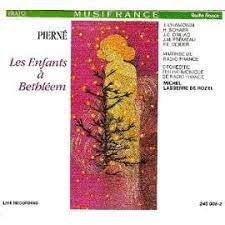The Vocal Retrospective
December 2021
 |
Ralph Moore |
Mike Parr |
 |
A series of monthly musings by two members of the MusicWeb International review team who share a deep fascination with opera and vocal music in general. Each month we shall take a glance back at something of interest that appeared on commercial CD from the accumulated history of classical vocal recordings.
Some lesser known Christmas oratorios
|
 |
|
Mike:
This month, as performances of Messiah begin to be advertised for the festive season, we decided to take a look at some recordings of Christmas oratorios that are not generally known and are rarely performed. Up first, is a recording of a work by Camille Saint-Saëns paired with an equally less-known piece by Ottorino Respighi. This recording was originally made in Stockholm in 1981 and released on vinyl by Proprius and Caprice records. It had to wait for a digital release until 2005 as a multi-channel SACD on the Proprius label.
Ralph:
When I am thinking about playing music for Christmas, my thoughts turn first to some obvious candidates, beginning with Berlioz’ L’enfance du Christ, whose gentle pathos seems to me to be perfect for the hushed expectancy of Christmas Eve. For Christmas Day itself, something more upbeat and celebratory is required, which is where Bach’s Weihnachtsoratorium (Christmas Oratorio) comes in. Then, of course, there is always Corelli’s Christmas Concerto, though there is nothing specifically seasonally festive about the music itself, except that it bears the inscription “Fatto per la notte di Natale” (Made for Christmas Eve).
Our choices here are a little more recherché, though no less apt. There aren’t that many recordings of Saint-Saëns’ Oratorio de Noël (Christmas Oratorio) – only four I am aware of – and I was not familiar with the one Mike chose for us to review, having always known the work from a recording conducted by Martin Flämig with the Dresdner Philharmonic and what sounds more like a band of gifted amateur singers than a professional outfit, but is nonetheless charmingly performed. That recording is available on both the Capriccio and Laserlight/Delta labels but this one under review is a rather more upmarket affair and conveniently paired with another of our seasonal pieces, Ottorino Respighi’s Lauda per la Natività del Signore (Carol for Our Lord’s Nativity - a “lauda” is a type of medieval and Renaissance Italian secular song usually associated with Christmas) and includes at least one star name in mezzo-soprano Ann Sofie von Otter. Our third piece is Gabriel Pierné’s Les enfants à Bethléem; both that and the Respighi were new to me, as I suspect they will be to many readers; furthermore, von Otter apart, I do not recognise a single performer in any of the three recordings, which is interesting and perhaps says more about my ignorance than their merits.
Saint-Saëns’ Christmas Oratorio is typically faux-archaic in style, mostly intimate, melodic and more of a cantata, at times reminiscent in both mood and music of Berlioz' much more celebrated Christmas oratorio mentioned above. It lasts under forty minutes and uses small forces, including a small orchestra with the organ and a harp playing prominent roles, a four-part choir including boys and five competent soloists - one of each category: a tenor, a soprano, a mezzo-soprano, a baritone and an alto - who sing a Latin text lifted from the narrative sections of the Gospel of St Luke with selections from the Christmas Mass and other biblical sources. Much of the music is lovely: the most memorable passages contain the gently rocking tune which opens the work and returns in the quintet with choir.
The Pierné, too, is deliberately antiquated and naïve in style, drawing on a medieval pattern, which is surely pardonable for a Nativity scene, although the libretto by Gabriel Rigond really is rather saccharine bearing in mind that this is music written around the same time as Strauss’ Elektra and Schoenberg’s Erwartung - not that I mind, you understand (especially about its lack of resemblance to the latter), whereas Respighi’s pastoral cantata is testimony to how he translated his attachment to medieval and Renaissance forms into his own, recognisably more modern idiom, as he did with his Antiche arie e danze (Ancient Airs and Dances).
This Proprius label recording has a rather austere and distant aural perspective compared with the Capriccio/Laserlight one I am used to; that uses a smaller, flutier organ in a warmer, closer acoustic and is much cosier and more charming in effect. The orchestral line of the Prelude really is so redolent of Berlioz that it is uncanny. I also find Eby’s tempo too brisk and his affect sometimes too grand, although the playing is undoubtedly skilful and his soloists are superior to Flämig’s team. The soprano and tenor solos in tracks 4 and 5 respectively are especially lovely and the tenor does not hold back in his more demonstrative passages; his air, “Domine, ego credidi” is exquisite – an operatic aria in its own right (remember: Saint-Saëns’ Samson et Dalila is a masterpiece). The bass, by contrast is rather nasal and disappointing – indeed, his is not a true bass sound but that of a tenor faking it. Flämig’s bass is slightly better, in fact, but not ideal, as he, too, hardly sounds authentic. There is little to choose between the choruses; both are animated and expressive, displaying real rhythmic rigour. The Trio with harp accompaniment starts enticingly but does not really fulfil its melodic promise although it has an ethereal conclusion; the ensuing “Alleluja” quartet is more stirring and involving, while the quintet, in which all five soloists participate in extending the “Alleluja“ refrain and the opening melody is reprised, is delightful – but again, it is taken a little too fast for my taste. The chorus pick up on the “Alleluja” yet again to deliver a rousing conclusion. This a small-scale work, but a very engaging one.
Mike:
The two most impressive aspects of the Saint-Saëns recording are the contributions of Erland Hagegård and Ann Sofie von Otter. Hagegård’s very distinguished tone has a fresh sound that communicates beautifully with the listener. While his voice is not especially large it does literally palpitate with emotion during his solos. Interestingly, he started his singing career training as a baritone but later switched to tenor. Similarly, the pure golden sound of the very young von Otter makes her the most patrician of Marys. Her warmly expressive singing of the air “Expectans Expectavi Dominus” is a real highlight of this piece. The soprano Britt-Marie Aruhn has a slightly glassy tone which nonetheless gives pleasure, especially when combined with the warmly gentle tone of baritone Ulf Lundmark in their duet. Lundmark is credited as both a baritone and a bass in the booklet but he definitely sounds like a baritone to my ears.
Ralph:
The sound-world of the Respighi piece, on the same disc, is very different, despite its thematic and seasonal links with the oratorio. The double reeds and flute in 6/8 rhythm are much more akin to the folksy Provençal or Occitanian world and the shimmering soprano line recalls Canteloube. Once again tenor Erland Hagegård distinguishes himself in the melismatic passages of his Shepherd’s lament over a male humming chorus, sustaining unfailingly beautiful, even tone, and Ann Sofie von Otter as Mary sings mellifluously.
It is noticeable how well the pulse of music sits so easily with the Italian text and there is much lovely solo playing from the oboe and two bassoons. The instrumental interludes are quirky and interesting two, employing hemiolas and switching tempi from bar to bar. The introduction of a piano and an insistent triangle into the shepherds’ Gloria are modernistic touches and the final chorus is capped by a serenely floated top A from the soprano Angel as Mary give thanks for the blessing bestowed upon her as mother of the Saviour and the pastoral oboe and bassoon bestow a blessing.
Mike:
The Respighi work should be much better known than it is. Respighi set a medieval poem by lawyer turned Franciscan monk Jacapone da Todi. Respighi provided a gorgeous yet simple orchestral palette that I tend to associate with the late Victorian Medievalist style of composition. Lasting only 22 minutes, it is a perfect concert work that ought to be trotted out for more Christmas concerts than has so far been the case. On this recording, Aruhn gets a better chance to display her talents as the Angel than she does in the Saint-Saëns work. Once again, Hagegård shines in his particularly lovely scene with a male chorus of shepherds, punctuated by tasteful woodwind accompaniment. The entire scene is quite breathtaking. Once again, von Otter’s Mary shows that she was deservedly on the brink of international stardom when this album was made.
|
 |
|
Ralph:
I happened to listen to Les enfants à Bethléem immediately after the Respighi and was struck by the fact that its oboe introduction could have been a continuation of the oboe solo concluding the Lauda. Pierné employs a narrator and the whole idiom then shifts unmistakably into a very French gear, with a children’s chorus echoing Bizet, Massenet and no fewer than five slim, shallow, sometimes shrill and very “Gallic” sopranos with an angel very different from the Swedish artists who perform the other two works. A couple of those sopranos are decidedly tremulous and unsteady but their fragility could be said to add to the naïveté of the work, as does the prominent contribution of the children’s choir, which sings very sweetly; otherwise, there is just one tenor and one baritone. The amount of spoken text means that a French libretto is essential if the non-French-speaking listener is to follow the narrative and appreciate the poetry.
To me, the music itself is at times rather fey and meandering and some of the conceits in the libretto rather mawkish – but these things are a matter of taste and no more sentimental than many a successful opera. The Star and the Holy Virgin, in particular, have some decidedly “operatic” arias, such as “Enfants blonds, enfants jolis” and “Le thym va fleurir” respectively and they are appealingly sung.
The work is in effect a kind of Christmas pageant, especially as the stable animals get to sing; at times the whimsical mood and even the sound of children’s music remind me of Menotti’s “Amahl and the Night Visitors”, especially in track eight, the arrival of the Three Kings – but of course, that was written almost half a century later. The animal scene is in fact rather touching, just as “Amahl” can be very moving in its simplicity.
The final scene with strumming harps, angelic choirs, a heavenly voice, the children’s prayer ascending to heaven and the dark premonition of the Cross voiced by Mary and the Star make a heady concoction, steeped in the kind of piety which might make some modern, secular listeners uncomfortable!
|
![vr-10-obscure-christmas-oratorios-5.jpg [image]](VR10-3.jpg) |
|
Mike:
Come on Ralph, at the Advent and Christmas seasons, who cares about making secular listeners happy? My feelings about the Pierné are more positive than yours. Christmas is generally a time stuffed full of sentiment anyway so I don’t consider applying the word sentiment to a piece of music to be a barrier to enjoying it. The text of the Pierné piece is a bit illogical in that it concerns the shepherd children of Bethlehem encountering the star which leads them to the stable. What is odd is that many of the lines refer to the frozen cold of the winter forest, the wind and so on. Obviously, this Bethlehem seems to inhabit some sort of remote Scandinavian locale rather than a Middle Eastern one.
Ralph:
I do not know why the English translation of “Do! Do! l’adoré” is rendered in the guise of Homer Simpson talk as “Doh, Doh, beloved”, as surely the translator was aware of the French “baby-talk” phrase “faire dodo”, presumably an abbreviation of “dormir” meaning “to go to sleep” or “to take a nap”; a better translation would simply be “Sleep, sleep, darling”. It’s also a pity that a strange little sound – a sneeze, a hiccup? – obtrudes towards the end, at 23:19 – but then, on first listening, I did not realise that this is a recording of a live performance, so quiet are the audience, until they applauded at the end.
Mike:
The musical highlights for me are the beautifully bright tone of soprano Jocelyne Chamouin as the Star of Bethlehem. She has a splendidly expansive top range that makes her interjections sound like shafts of light in the darkness. Hanna Schaer is firm but slender-toned Mary, not quite in von Otter’s league. One of the best pieces in the score is the delightful March of the Three Kings; it is scored in a charming minor mode that exudes both off-kilter grandeur and sly humour. I find that the substantial part of the speaker who delivers his lines over a timed orchestral accompaniment is quite reminiscent of the Prologue to Massenet’s final opera Amadis, which was composed a few years before Les enfants à Bethléem but was premiered posthumously in 1922. Those lines are trenchantly delivered by eminent actor and stage director Paul-Émile Deiber; who was Christa Ludwig’s second husband. The conductor Michel Lasserre de Rozel really immerses himself in the charm and mood of the work and draws some shimmering playing from the Radio France Orchestra and the very well-prepared children’s chorus.
Camille Saint-Saëns
Oratorio de Noël (1863)
Ottorino Respighi
Lauda per la Nativita del Signore (1930)
1981 (studio, stereo)
Proprius PRSACD 9057 SACD [57:43]
Orchestra and the Mikaeli Chamber Choir/Anders Eby
Ann Sofie von Otter
Britt-Marie Aruhn
Ing-Mari Landin
Erland Hagegård
Ulf Landmark
This recording is still available to purchase on SAC or for downloading through Presto Classical. It can also be located on streaming services such as Apple Music, the Naxos Music Library and Spotify
Gabriel Pierné
Les enfants à Bethléem (1907)
1987 (Live, stereo)
Erato 2292-45008-2 CD [56:39]
Maîtrise and l’Orchestre Philharmonique de Radio France/Michel Laserre de Rozel
Jocelyne Chamouin
Hanna Schaer
Jean-Claude Orliac
Jean-Michel Frémeau
Paul-Émile Deiber
This recording is no longer available to purchase on CD or for streaming online however; it can be found on YouTube
here.
To our readers: Ralph and Mike will be taking a little break away from the retrospective for the winter months. We hope to resume our activities next spring.
